FRENCH LETTER
Say prunes (in a plummy voice)
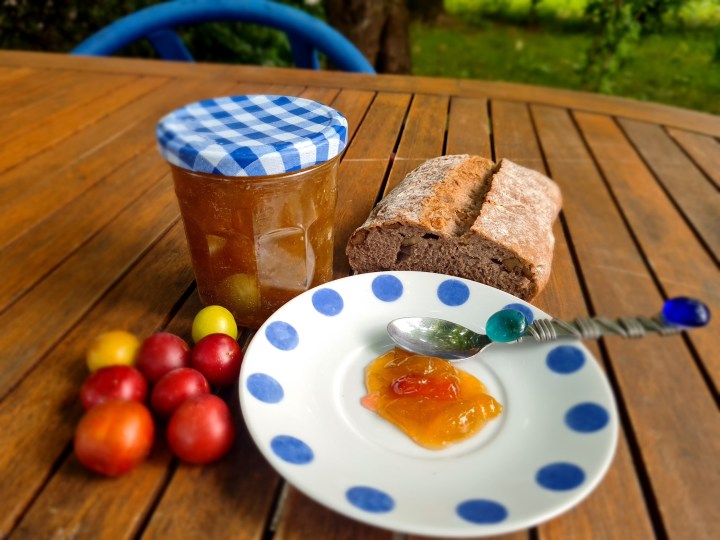
Recently we drove through Agen, which turned our thoughts to juicy black prunes, and back in our rented house in Périgord we discover plums ripening on at least three of the many trees we couldn’t identify when we moved here in the midst of winter.
I have learned to appreciate prunes in France, especially those black beauties from Agen that are crowned with the prestigious IGP label (Protected Geographical Indication), but I’m still not a big fan of plums. And since prunes are only the older and dried-out version of plums, it is probably like saying I prefer old women with wrinkled faces to fresh-faced young beauties.
Well, sometimes I do. Just as there is a depth of experience visible in some lined faces that make them more beautiful than an empty youthful face, there is a depth of taste and complicated sweetness in an Agen prune that I have yet to encounter in any fresh plum.
Still, when life gives you lemons, hey? At the moment life is handing me plums, in profusion, so I’m carrying them to the kitchen and exploring ways of turning them into the proverbial lemonade. While pondering on plums and prunes, youth and old age, innocence versus experience. Who says cooking can’t be a philosophical exercise?
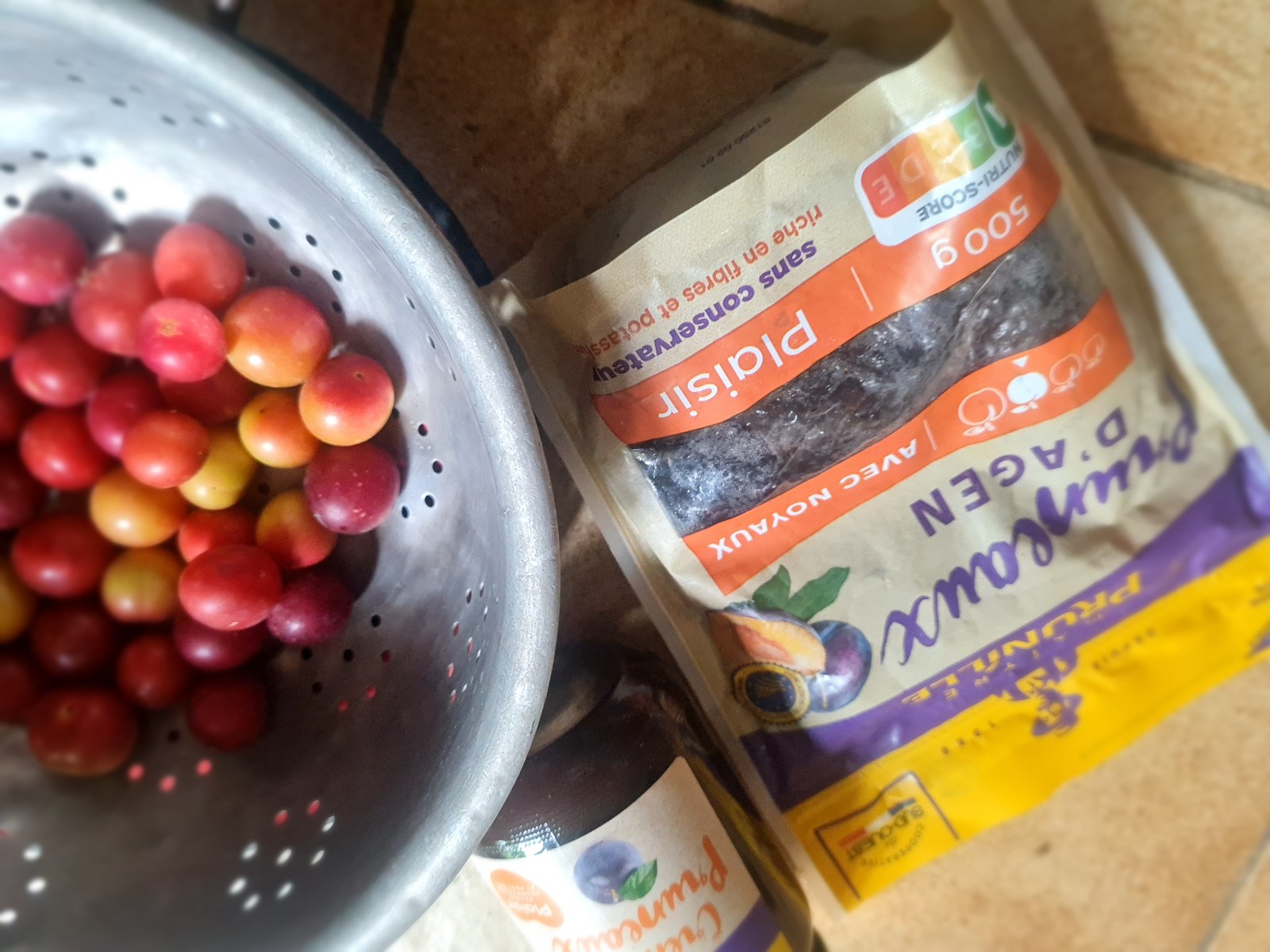
Prunes and prune cream from Agen plus plums from our tree. (Photo: Marita van der Vyver)
I researched the history of plums and prunes years ago while working on a food book, and I still remember what I wrote about the early days of photography in Winter Food in Provence: “Photographers would call out ‘Say prunes!’ from behind their enormous cameras to ensure that their subjects’ lips maintained a flattering pout during the long posing process. It was only when automatic cameras speeded up the process considerably – and dental health was so greatly improved that subjects were prepared to have their image recorded for posterity with a broad smile – that the modern ‘Say cheese!’ came into common use.”
More recently I learned that the word “plums” had previously been used for other dried fruit like raisins or figs too, which probably explains why there are no plums in the modern version of the famous British plum pudding.
By the early 19th century, in fact, “plum” could denote just about anything desirable. That is why we still talk about a plum job, or a plummy accent, which used to be a desirable upper-class way of talking but is nowadays mainly used in a mocking way.
Who says cooking can’t teach us about history and etymology too?
Something else that cooking and a love of good food teach us is to travel in a more adventurous way. Even a short day trip can become memorable when you make a point of trying out local food products. On a road trip through the South African platteland last year, my Frenchman and I tasted nastergal jam and bokkoms, chunks of makataan conserve and vetkoek, koeksisters, koesisters and samoosas to die for. For him, many of these tastes were a first – for me, it tasted like home.
When we travel in France, the roles are swapped, with him playing the connoisseur and me the curious novice. And the choice is wider than anywhere else on earth. It is almost impossible to travel in this country for more than a day without finding yourself in the birthplace of some or other famous food product, a town that gave its name to a renowned recipe, a remote village known all over the world because of an eponymous cheese or biscuit produced there since the dawn of time.
If you’re a food lover, you’ll want to taste mustard while you’re in Dijon, tripe when in Caen, olives in Nyons, walnuts in Grenoble, and the list goes on and on. This is why we had to stop in Agen, about two hours drive southwest of where we live, on a recent road trip to Spain. Of course, we can buy those IGP Agen prunes in our local supermarket too, but that is not the same as buying Agen prunes in Agen.
When I travel, I buy food products as souvenirs, like other travellers might buy postcards or fridge magnets, to recall the trip once I’m back home. Before my partner retired, I used to travel mainly on my own, and I would invariably bring back some edible gift as a way of sharing with him the taste of whichever faraway country or region I visited without him. Fortunately, he loves new tastes as much as I do, so the gifts were always welcomed with open arms, open mind and open mouth.
So we bought prunes, crème de pruneaux and other prune products during our pit stop in Agen (sorry, the pun just slipped in), and last week we used some of the prunes for a simplified version of the traditional French dish called porc aux pruneaux.
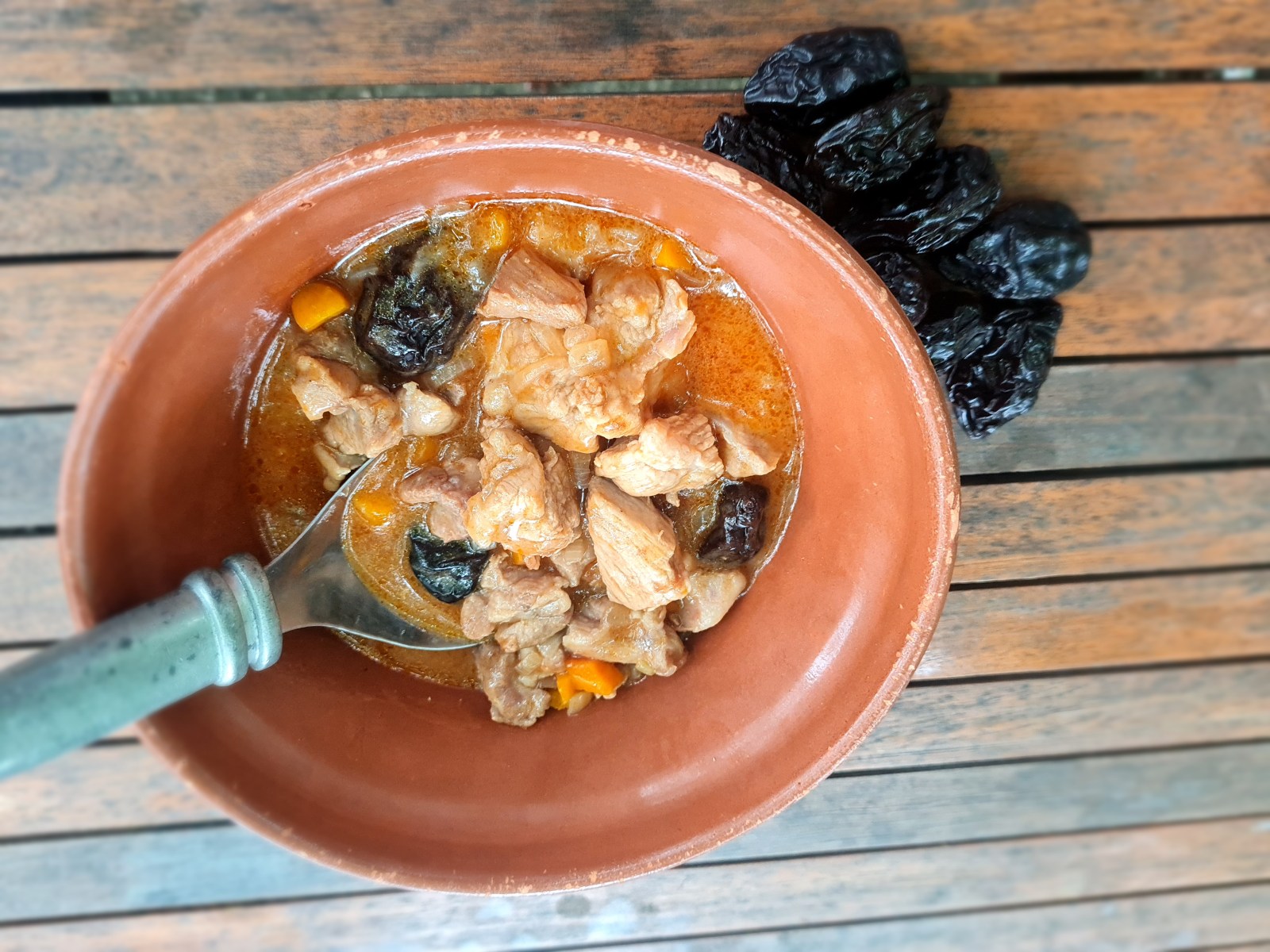
A simplified version of porc aux pruneaux. (Photo: Marita van der Vyver)
In France, pork and prunes are a match made in heaven, like scones and cream in England, or pasta and Parmesan in Italy, or any of those culinary combos that have become part of our international food culture.
Outside of France, alas, prunes don’t always get the respect they deserve, especially in Anglo-Saxon countries where they are often regarded as “little more than a laxative’”.
I’m quoting from my favourite food encyclopaedia, 1001 Foods You Must Try Before You Die, which chooses Agen prunes, bigger, fatter, more succulent than most others, as the prune that should be on your bucket list. But this lack of respect was demonstrated once again by an (Anglo-Saxon) acquaintance who was horrified when he heard we were planning a dish of pork and prunes.
Apparently one of his French neighbours “treated” him to a ghastly dish of porc aux pruneaux – which confirmed all his suspicions about the laxative nature of prunes.
All I can say is that any dish can be ruined by an incompetent cook. The prunes in a good porc aux pruneaux should be used stingily, and only added towards the end of the cooking process, otherwise, they turn into an overly sweet mush that overpowers all the more subtle flavours. Not to mention the possible laxative results.
We used exactly eight Agen prunes for about 600g of pork – and I had to plead for the last two because the Frenchman in the kitchen wanted to use only six. Since my South African tongue is more accustomed to sweet and savoury flavours mixed together, I really enjoyed the added sweetness of the two extra prunes. But I also know that too much of a good thing is not good – maybe even more so when that good thing is a good prune – and I wouldn’t dare to double the number of prunes.
Plums, on the other hand, are a good thing of which we have more than we know what to do with at the moment. Our rented house has an overgrown garden with a variety of old fruit trees that haven’t been pruned for years (this time the pun is truly unintended), perhaps even decades, with the result that most of the fruit grow on branches too high to reach, even with a ladder. Throughout the cherry season last month, we could only gaze longingly at the little red cherries tempting us from the highest branches, while birds and insects feasted on the free food.
The plum trees seem more obliging, especially the biggest one bearing loads of small plums in shades of yellow, orange and red. Many of these are as unattainable as the cherries were, but there are still more than enough low-hanging fruit for us to harvest.
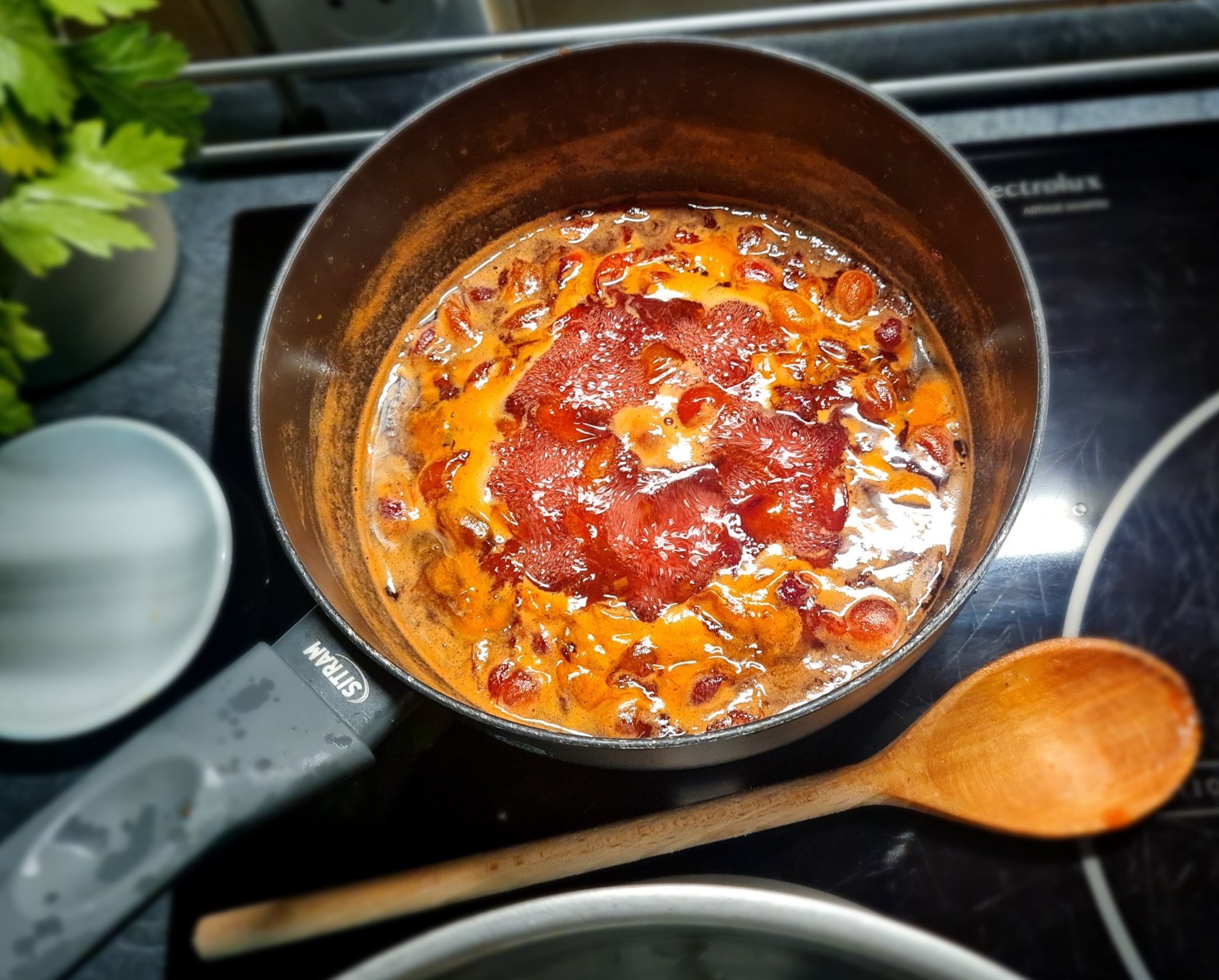
Cooking plum jam. (Photo: Marita van der Vyver)
And harvest we do, storing some in the freezer, making jam from others, roasting some in the oven to eat with duck or turkey. We also baked plum clafoutis, not bothering to take out the pips first, since a traditional clafoutis requires cherries with pips – and these plums are not much bigger than a plump cherry anyway.
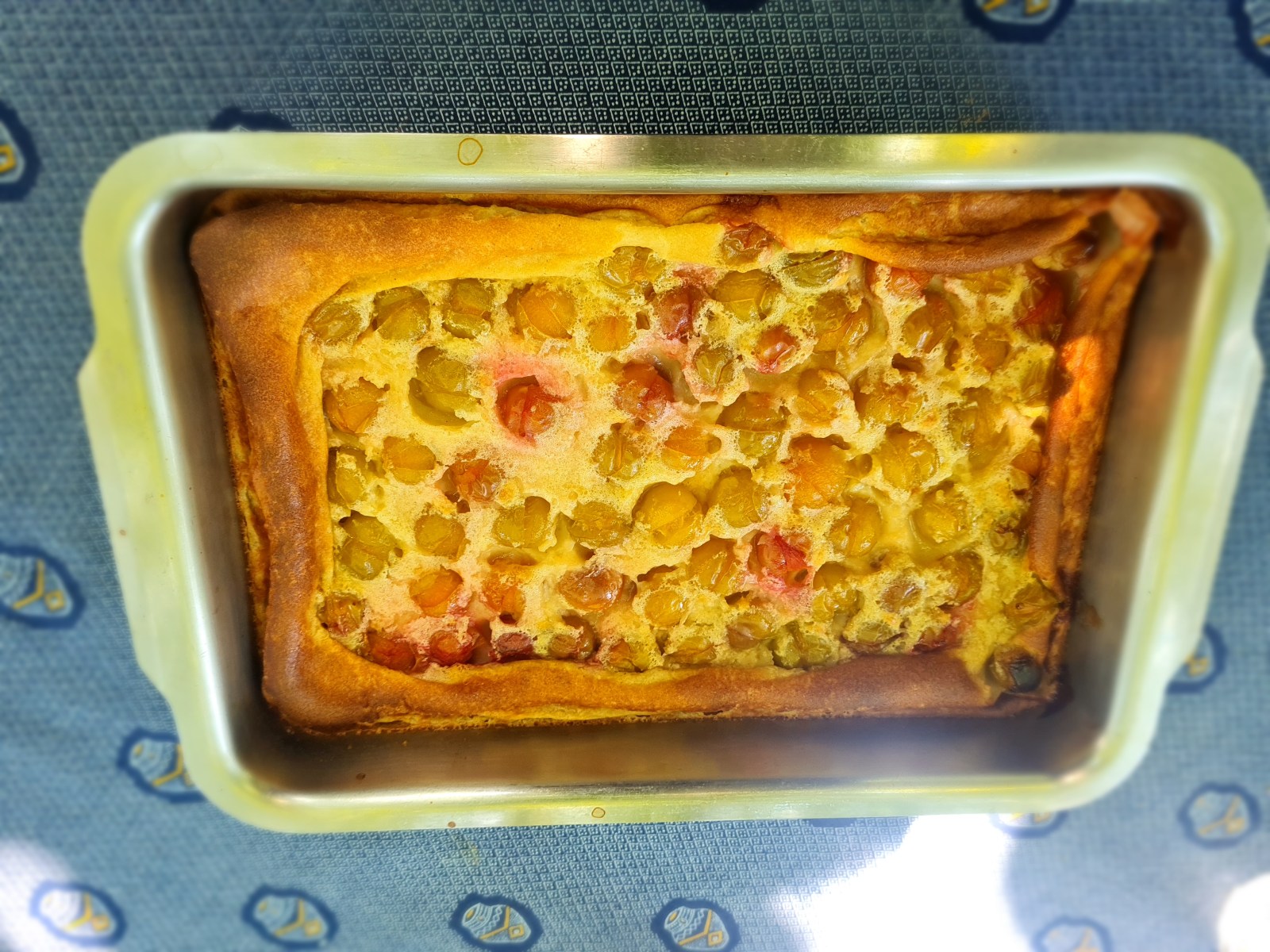
Plum clafoutis, pips and all. (Photo: Marita van der Vyver)
From time to time I even pop a few fresh from the tree into my mouth, recalling little Jack Horner sitting in his corner and wondering, as I always do, why the silly boy used his thumb to pull out that plum. The plums from our trees are far too dainty to dig your thumb into, so the nursery rhyme plum must have been one of those fat blue-black ones. At any rate, I’m beginning to like plums. By the end of summer, I might even love them as much as prunes.
Meanwhile, an unknown neighbour knocked on our front door a few days ago to invite us to a communal midsummer meal organised in a field just outside the village, where the inhabitants light a huge bonfire each year.
The festival is known as Les feux de St Jean, another of the many Catholic rituals taken over from pagan times when these fires celebrated the summer solstice. When our neighbour asked if we could bring something sweet to eat, we immediately knew what to do with our profusion of plums. We baked a sweet and simple old-fashioned Mirabelle tart to share with our neighbours.

Midsummer meal in a meadow, sharing food with neighbours. (Photo: Marita van der Vyver)
It was the kind of evening that reminded me of scenes from French movies I used to watch yearningly long before I knew I would ever live in this country. We sat at a long table in a field, we watched the sun set in an orange blaze, we listened to the hum of happy voices, and we tasted each other’s culinary offerings. A quiche that one neighbour made with spinach growing in her garden, the cherry liquor that another made from the cherries in his orchard, a paté de campagne from someone else’s pantry.
I sometimes forget that this version of the French countryside still exists.
It reminded me of something else too, as I watched our neighbours enjoying every last crumb of our tart made with plums falling from heaven. The most pleasing way to deal with an abundance of anything good is still, simply, to share it. DM





absolutely adore this column- my spiritual home is France and Marita brings the senses alive!
No recipes?.·´¯`(>▂<)´¯`·.
Especially the pork and prune one.
I’m left wondering what a fresh (not dried) Agen prune tastes like…